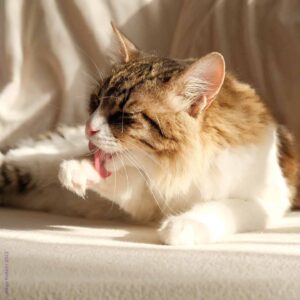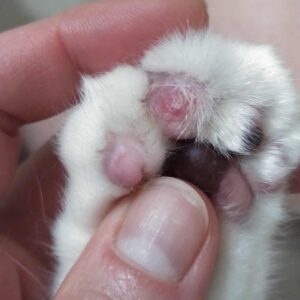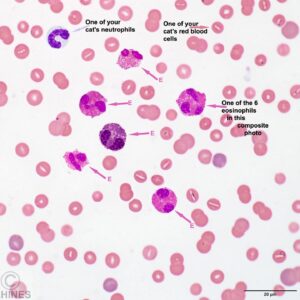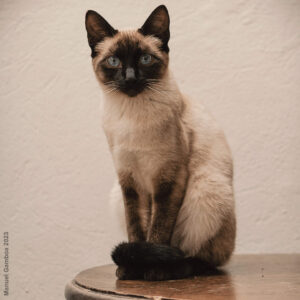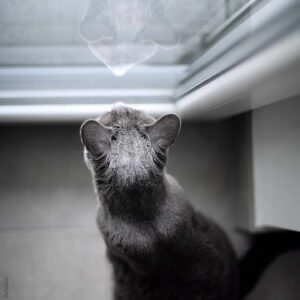Why Is My Cat Scratching, Losing Its Hair And Licking Itself Raw?
What Is Making My Cat Lick Its Paws And Body Too Much?
Ron Hines DVM PhD
 What Are Those Painful-Looking Red Sores On My Cat’s Lip Or Body?
What Are Those Painful-Looking Red Sores On My Cat’s Lip Or Body?
Licking and self-grooming are so basic to your cat’s nature that it can be hard to decide when they cross the line from normal to abnormal behavior. Content, normal, indoor house cats spend up to a third of their day grooming themselves. So most cat owners only realize they have a problem when their cat’s hair begins to thin or becomes inflamed. When a dog licks itself excessively, that behavior often remains a quirky idiosyncrasy without much physical damage – like nibbling at your fingernails. But when a cat’s self-licking passes from normal grooming behavior into an obsession, their unique, raspy tongue rapidly causes hair loss, skin abrasions and secondary infections. The sharp hair-like growths (lingual papilla) that you see and feel on the tip of your cat’s tongue act just like a wire brush.
How Do I Know When My Cat Is Licking Excessively?
Your cat has a licking problem when:

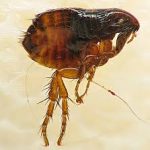
Fleas, not some rare disease, belong at the top of this list. Fleas – even one flea, can cause a cat to frantically chew off its fur in attempts to catch it. If you look closely, it is a biting motion, not a licking motion. When your cat develops a flea bite saliva allergy, hair loss can be extreme. A flea saliva allergy, which is not the same as a simple flea infestation, is sometimes accompanied by lip ulcers. (read here & here) Cats with a flea problem often develop scabs along their back near the base of their tail, as well as surrounding their neck. Your veterinarian will take a look in your cat’s ears to be sure ear mites are not the cause. Over time, your cat’s coat might become thin and ragged. It is unclear why some cats are more annoyed by fleas than others. It is common for one cat in a multi cat household to suffer more than the rest. Perhaps it is due to that cat’s favorite lounging area being more infested with fleas than another, your particular cat’s unique sensitivity to flea saliva, heightened individual skin sensitivity, or its unique temperament. Just because you never find a flea on your cat is not proof that fleas are not all or part of its skin problem. The presence of pepper-sized grains of blackish material (flea feces) that “bleed” a rust-colored pigment when moistened, is all the evidence required. But cats often lick that evidence off quite rapidly. Another for-certain sign is the presence of pygmy tape worm segments on your cat’s rear end or on its stool. That is why most veterinarians and veterinary dermatologists incorporate a systemic monthly flea-control product in their treatment plan – no mater what their probable diagnosis. You can read more about your options when dealing with fleas here.

Your cat is a creature of habit. Be suspicious when its licking behavior varies from day to day, week to week or month to month. Particularly, when nothing else has changed in its life. Normal indoor cats do not experience heavy seasonal sheds the way some dog breeds do. Your cat’s hair coat should never be patchy. It might be a bit thicker in the winter than during summer months, but there should never be times when the hair on its belly, rear thighs or, for that matter, anywhere else on its body becomes thin. Thighs and belly are favorite over-licking areas. When dogs loose hair in a symmetrical pattern on both sides of their bodies, the underlying problem is often hormonal. That is not the case in cats. When they show a similar (‘saddle”) hair loss, they have generally been licking their hair off. You might not see them doing the licking because cats can be more secretive about licking and scratching than dogs. Increased dandruff and scruffiness are also common in cats that over-lick. It is normal for the hair on your cat’s temples to thin as it ages. But it should be the same on both temples. If hair loss is accompanied by scratches or scabs, your cat’s ears need to be checked by your veterinarian for ear mites or infection. If neither are the cause, then checked for ringworm, notedric or sarcoptic mange. and ringworm. Many of the products used to treat mange on dogs are unsafe to use on cats. Be sure you see a cat on the label of any product you apply or any oral medication you administer to your cat. Any of the cat-approved products that you see on this page should eliminate mange mites, as well as fleas and ear mites, although it will take several monthly applications to entirely eliminate them because these products kill adult parasites, not their residual eggs. Bacterial and fungus infections are almost never the underlying causes of hair loss in cats, they are almost always secondary invaders taking advantage of another underlying health issue.
 Your cat’s paws should be dry to the touch. If they remain damp when your home environment is dry, suspect a problem. If your cat’s paws are puffy, have a distinct off odor, show areas of discoloration, ulceration or are sensitive to the touch, there is a problem. Blisters, growths or burns are always abnormal. Paw infections can also cause cats to limp, lick or be reluctant to move about, jump or climb stairs. Toenails that are cracked, broken or bleeding occur in many skin problems in which excessive licking/scratching is present. It is also possible for cats to develop autoimmune issues that involve their skin. (read here & here) If your cat has been declawed, occasionally a remnant of a removed claw was missed. Those cats will lick that paw and perhaps even limp. In elderly cats, the presence of a skin tumor must also be considered.
Your cat’s paws should be dry to the touch. If they remain damp when your home environment is dry, suspect a problem. If your cat’s paws are puffy, have a distinct off odor, show areas of discoloration, ulceration or are sensitive to the touch, there is a problem. Blisters, growths or burns are always abnormal. Paw infections can also cause cats to limp, lick or be reluctant to move about, jump or climb stairs. Toenails that are cracked, broken or bleeding occur in many skin problems in which excessive licking/scratching is present. It is also possible for cats to develop autoimmune issues that involve their skin. (read here & here) If your cat has been declawed, occasionally a remnant of a removed claw was missed. Those cats will lick that paw and perhaps even limp. In elderly cats, the presence of a skin tumor must also be considered.
Another poorly understood feline disease, plasma cell pododermatitis, will cause cats to lick their paws. It shares many of the characteristics of an autoimmune disease. Although corticosteroids such as prednisolone give temporary improvement, cats tend to relapse once the medication is discontinued. Currently, doxycycline antibiotic is preferred. (read here) Cats with unexplained skin problems need an FeLV/FIV test.
 An increased frequency of gagging, hairballs or constipation often occurs in cats that are over-grooming. That is because so much of that hair gets ingested. Of course, it will affect cats with long hair coats the most. When mites or fleas are your cat’s underlying over-grooming problem, it’s not uncommon for your veterinarian to detect parasite parts or eggs microscopically in your cat’s stool. Petrolatum-based cat laxatives solve constipation problems quite well – but not their underlying causes. Some believe that too frequent a use of those oil-based products robs your cat of the fat soluble vitamins, A, D, E, & K. Many other health issues other than over-grooming could be the cause. An issue such as megacolon, chronic dehydration, intestinal tumors, medications that slow your cat’s stomach emptying or slow intestinal motility, or partially obstructing foreign bodies, any of which are capable of being the underlying cause.
An increased frequency of gagging, hairballs or constipation often occurs in cats that are over-grooming. That is because so much of that hair gets ingested. Of course, it will affect cats with long hair coats the most. When mites or fleas are your cat’s underlying over-grooming problem, it’s not uncommon for your veterinarian to detect parasite parts or eggs microscopically in your cat’s stool. Petrolatum-based cat laxatives solve constipation problems quite well – but not their underlying causes. Some believe that too frequent a use of those oil-based products robs your cat of the fat soluble vitamins, A, D, E, & K. Many other health issues other than over-grooming could be the cause. An issue such as megacolon, chronic dehydration, intestinal tumors, medications that slow your cat’s stomach emptying or slow intestinal motility, or partially obstructing foreign bodies, any of which are capable of being the underlying cause.
Injuries
Cats will lick any skin injury, particularly if the skin has been broken or abraded. Check your cat’s paws for an embedded thorn or broken toenail. Paw injuries also occur from contact with hot objects, such as your stove. If your cat roams outside unattended, defending its territory often results in an abscess. When they are on your cat’s front legs or shoulders, it was probably standing its ground defending its territory. When on its tail, back leg or buttocks, attempting to escape. After an encounter of that sort, it is common for cats to show no lump or swelling – just an elevated temperature. But pressing on those areas causes them considerable pain. Oral bacteria from the biting cat have already been injected into your cat. Those cats are already running a fever at home at or above 102.5 F/39.2C. Normal cats often run a few decimal points higher at veterinary hospitals, due to their anxiety. In those cases, it can be ignored if no painful areas are found, there is no history of a bite and no signs of depression. In abscess cases, a broad spectrum antibiotic at that point may nip the problem in the bud. Untreated, after another few days, a pus-filled bulge is likely to form, and later a draining tract. Fever subsides once the pus has drained or the abscess has been lanced and attended to by your veterinarian. Throughout that period, your cat is likely to lick that area. Putting topical ointments or sprays on these types of wounds without some form of physical restraint or topical bandage is never effective. Cats lick these products off as fast as they are applied. Medications need to be those given orally or by injection. If, by chance, a skin suture was inadvertently not removed after your cat was spayed or neutered, that suture can be the source of irritation and licking. A patchy hair loss can also be due to topically applied medications or occur at the site of a recent vaccination or injection. If the latter, your vet needs to take a look at that.
Eosinophilic Granuloma Complex
Eosinophilic granuloma complex or EGC is a term used for a number of skin, eye and intestinal issues in which abnormally large numbers of eosinophils, one of the cells of your cat’s immune system, congregate in the tissue. Eosinophils are produced in your cat’s bone marrow and float free in its blood stream until needed. High concentrations are associated with allergies or parasitic infections. In some cases, a hypersensitivity to fleas appears to be the cause, in others, perhaps a host of other hypersensitivities or “allergies”. No matter what the underlying cause, all respond favorably to medications that suppress the cat’s immune system, with all the dangers doing so entails. So saying your cat has an EGC problem is like saying it has a vomiting problem. The real question is why.When large areas of the cat are affected by EGC in its crusty rash or red bump form, it is often called miliary dermatitis. You can read about the skin form of this disease here.
Other Allergies And Sensitivities That Might Be Involved In Over-licking
The relationship between the Eosinophilic complex disease I just described and traditional allergies or food sensitivities is unclear. But an abnormally high number of eosinophils are not present in many cats that are losing hair due to over-grooming. Veterinarians call these allergies feline atopy. (read here & here) Veterinarians also think that the same processes that occur in feline atopy probably occur in feline asthma. (read here) Both problems are nearly impossible to treat by removing offending airborne contaminants and pollen. You can avoid exposure of your cat to perfuming agents added to cat litter, household cleaning products, sanitizers, deodorants and industrial chemicals incorporated into common household goods and carpeting. They have all been occasionally implicated. Occasionally (but not commonly) food ingredients are thought to be the trigger. When exposure is unavoidable, cats with either problem do best when given prednisolone during flareup periods. During those times, increased body weight and elevated blood glucose levels need to be prevented. Prednisolone and prednisone and drugs with the same abilities are all corticosteroids. And corticosteroids encourage appetite and fluid retention. For reasons unknown, certain breeds like Siamese and Bengals seem more prone to having these problems. I would avoid drugs such as cyclosporin and Apoquel® if at all possible. (read here & here)
I believe that allergies to your cat’s food ingredients are not the cause of itching in many felines. At least, only a few cats with itching and/or digestive tract issues are cured by diet changes – although a few improve temporarily or permanently. But changing your cat to a hypoallergenic diet is something you can easily do. See what happens after a month on a new diet. I suggest well cooked chicken quarters with the bones removed, along with cooked chicken liver once a week for its vitamin A & D3 content, along with a sprinkling of powdered eggshell. An occasional cooked egg yolk is another good source of A & D3. The egg white is nutritious as well. The orange tabby cat in the photo above is enjoying that diet. If your cat improves, it can stay on that diet indefinitely, or you can slowly introduce other ingredients and observe the effect. You can purchase commercial hydrolyzed prescription hypoallergenic diets. But many cats won’t eat them. You could also try your cat on a novel, meat-based cat food.
Anxiety And Stress (Psychogenic Alopecia)
Cats, faced with stress, or the inability to perform things they are accustomed to, can respond with exaggerations of the common activities they still find pleasurable and comforting. Grooming is one of them. Psychogenic or stress-related hair loss can be one of the symptoms of a cat having to deal with stress and worries of one form or another (a displacement behavior). When grooming becomes an obsession, your cat might develop a thin hair coat or bald areas. These areas are usually similar on both sides of its body. Any reachable area of your cat can be affected, but the cat’s flanks and thighs tend to show the most hair loss. If the problem persists, only the areas that are difficult for your cat to reach remain normal. Skittish and nervous cats, as well as cats that live in group homes, seem more prone to this problem. However, it only becomes the likely diagnosis when all tests have ruled out organic causes. The loss of a companion pet, a caregiver, or major changes in the home environment can also trigger this problem. Some breeds, such as Siamese, Bengals, Burmese, Balinese and Tonkinese appear to be more emotionally sensitive and apt to develop stress-related hair loss. I see more cats with this problem that share the thin, “Pink Panther” physique than plumper felines, and more often in female than male cats. They are also the cats most likely to be “wool suckers”. The best treatment for compulsive cats is to divert their attention to activities that are not self-destructive. If your cat is elderly, if it is becoming thin despite having a good appetite, a blood test for hyperthyroidism needs to be performed. Besides an abnormally high metabolism, a few of these cats have patchy hair loss or an unkempt appearance without any signs of itchiness.
Feline Hyperesthesia Syndrome
Feline hyperethesia syndrome or “ghost pain” is a rare but dramatic condition of cats that is poorly understood. Cats that are at risk for other compulsive behavioral problems appear to be more at risk of this problem as well. Most veterinarians believed it to be a neurological problem, in which the perception of itching or pain occurs in areas where no visible cause can be found. It is also likely that a number of similar appearing problems with entirely different causes might be lumped together under this diagnosis. During these episodes, your pet might vocalize as well. The skin on its back might ripple or spasm. It might appear out of touch with its owners and its environment during these episodes. Some describe their demeanor as “pouting”, others as being “distant” still others as “my cat is having a tantrum”. Cats with this problem have been known to attack their owners during an episode. During periodic bouts, many become hyperactive, overly alert and wide-eyed – as if they were on some form of psychotropic medication. In humans, something, perhaps similar, is referred to as dysesthesia. Some of these cats are sensitive along their backs when touched. Some chase or swish their tails. Others might snap at imaginary objects. A few cats progress to seizures. But before you jump to any conclusions, be sure that biting fleas are not the cause of your cat’s bizarre behavior. It is hard for your veterinarian to treat a disease for which the symptoms are apparent, but the cause remains unknown. Most vets attempt to control this problem with mixtures of human antidepressant and anti-compulsive medications and/or drugs known to control epilepsy and various psychoses. (e.g. Prozac®, amitriptyline, clomipramine, phenobarbital) Complete cures are unlikely, but improvements are common. Deciding which medication performs best for your cat and at what dose is by trial and error. One also needs to be sure that these cats are not suffering from the “dry” form of FIP, hyperthyroidism, or toxoplasmosis and that they are FeLV & FIV negative. If you allow your cat to roam and neglect its vaccinations, rabies also needs to be considered.
Other Underlying Health Issues
Cats with health issues that are not primarily skin problems often look bedraggled and ill kept. In their poor health, they become apathetic about grooming, and they might not replace lost hair at the rate they once did. In multicat households, one must also be sure that it is not another of your pets that is over grooming or bullying the affected cat.
You are on the Vetspace animal health website
Visiting the products that you see displayed on this website help pay the cost of keeping these articles on the Internet.

